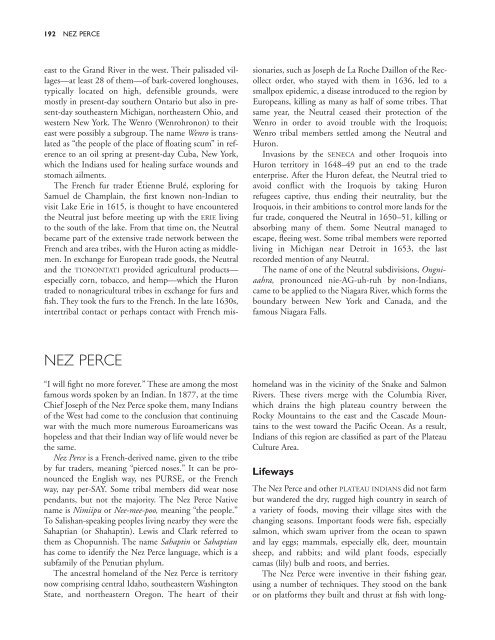Create successful ePaper yourself
Turn your PDF publications into a flip-book with our unique Google optimized e-Paper software.
192 NEZ PERCE<br />
east to the Grand River in the west. Their palisaded villages—at<br />
least 28 <strong>of</strong> them—<strong>of</strong> bark-covered longhouses,<br />
typically located on high, defensible grounds, were<br />
mostly in present-day southern Ontario but also in present-day<br />
southeastern Michigan, northeastern Ohio, and<br />
western New York. The Wenro (Wenrohronon) to their<br />
east were possibly a subgroup. The name Wenro is translated<br />
as “the people <strong>of</strong> the place <strong>of</strong> floating scum” in reference<br />
to an oil spring at present-day Cuba, New York,<br />
which the Indians used for healing surface wounds and<br />
stomach ailments.<br />
The French fur trader Étienne Brulé, exploring for<br />
Samuel de Champlain, the first known non-Indian to<br />
visit Lake Erie in 1615, is thought to have encountered<br />
the Neutral just before meeting up with the ERIE living<br />
to the south <strong>of</strong> the lake. From that time on, the Neutral<br />
became part <strong>of</strong> the extensive trade network between the<br />
French and area tribes, with the Huron acting as middlemen.<br />
In exchange for European trade goods, the Neutral<br />
and the TIONONTATI provided agricultural products—<br />
especially corn, tobacco, and hemp—which the Huron<br />
traded to nonagricultural tribes in exchange for furs and<br />
fish. They took the furs to the French. In the late 1630s,<br />
intertribal contact or perhaps contact with French missionaries,<br />
such as Joseph de La Roche Daillon <strong>of</strong> the Recollect<br />
order, who stayed with them in 1636, led to a<br />
smallpox epidemic, a disease introduced to the region by<br />
Europeans, killing as many as half <strong>of</strong> some tribes. That<br />
same year, the Neutral ceased their protection <strong>of</strong> the<br />
Wenro in order to avoid trouble with the Iroquois;<br />
Wenro tribal members settled among the Neutral and<br />
Huron.<br />
Invasions by the SENECA and other Iroquois into<br />
Huron territory in 1648–49 put an end to the trade<br />
enterprise. After the Huron defeat, the Neutral tried to<br />
avoid conflict with the Iroquois by taking Huron<br />
refugees captive, thus ending their neutrality, but the<br />
Iroquois, in their ambitions to control more lands for the<br />
fur trade, conquered the Neutral in 1650–51, killing or<br />
absorbing many <strong>of</strong> them. Some Neutral managed to<br />
escape, fleeing west. Some tribal members were reported<br />
living in Michigan near Detroit in 1653, the last<br />
recorded mention <strong>of</strong> any Neutral.<br />
The name <strong>of</strong> one <strong>of</strong> the Neutral subdivisions, Ongniaahra,<br />
pronounced nie-AG-uh-ruh by non-Indians,<br />
came to be applied to the Niagara River, which forms the<br />
boundary between New York and Canada, and the<br />
famous Niagara Falls.<br />
NEZ PERCE<br />
“I will fight no more forever.” These are among the most<br />
famous words spoken by an Indian. In 1877, at the time<br />
Chief Joseph <strong>of</strong> the Nez Perce spoke them, many Indians<br />
<strong>of</strong> the West had come to the conclusion that continuing<br />
war with the much more numerous Euroamericans was<br />
hopeless and that their Indian way <strong>of</strong> life would never be<br />
the same.<br />
Nez Perce is a French-derived name, given to the tribe<br />
by fur traders, meaning “pierced noses.” It can be pronounced<br />
the English way, nes PURSE, or the French<br />
way, nay per-SAY. Some tribal members did wear nose<br />
pendants, but not the majority. The Nez Perce <strong>Native</strong><br />
name is Nimiipu or Nee-mee-poo, meaning “the people.”<br />
To Salishan-speaking peoples living nearby they were the<br />
Sahaptian (or Shahaptin). Lewis and Clark referred to<br />
them as Chopunnish. The name Sahaptin or Sahaptian<br />
has come to identify the Nez Perce language, which is a<br />
subfamily <strong>of</strong> the Penutian phylum.<br />
The ancestral homeland <strong>of</strong> the Nez Perce is territory<br />
now comprising central Idaho, southeastern Washington<br />
State, and northeastern Oregon. The heart <strong>of</strong> their<br />
homeland was in the vicinity <strong>of</strong> the Snake and Salmon<br />
Rivers. These rivers merge with the Columbia River,<br />
which drains the high plateau country between the<br />
Rocky Mountains to the east and the Cascade Mountains<br />
to the west toward the Pacific Ocean. As a result,<br />
Indians <strong>of</strong> this region are classified as part <strong>of</strong> the Plateau<br />
Culture Area.<br />
Lifeways<br />
The Nez Perce and other PLATEAU INDIANS did not farm<br />
but wandered the dry, rugged high country in search <strong>of</strong><br />
a variety <strong>of</strong> foods, moving their village sites with the<br />
changing seasons. Important foods were fish, especially<br />
salmon, which swam upriver from the ocean to spawn<br />
and lay eggs; mammals, especially elk, deer, mountain<br />
sheep, and rabbits; and wild plant foods, especially<br />
camas (lily) bulb and roots, and berries.<br />
The Nez Perce were inventive in their fishing gear,<br />
using a number <strong>of</strong> techniques. They stood on the bank<br />
or on platforms they built and thrust at fish with long-


















